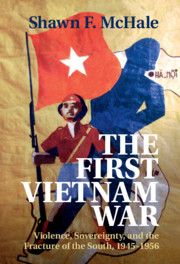Book contents
- The First Vietnam War
- The First Vietnam War
- Copyright page
- Contents
- Figures
- Tables
- Acknowledgments
- Abbreviations
- Introduction: Sovereignty, Violence, and Institutional Collapse at the Edge of France’s Empire
- Part I Fracture, 1945–1947
- Part II Disassemblage/Reassemblage, 1947–1953
- 5 Empire, Racial Survival, and Race Hatred
- 6 Contesting State and Sovereignty
- 7 Forced Migrations and Suffering
- 8 French Pacification Meets the Vietnamese Resistance
- 9 Alternative Trajectories: Seeing like Parastates, Militias, and Strongmen
- Part III Endgame, 1953–1956
- Bibliography
- Index
6 - Contesting State and Sovereignty
from Part II - Disassemblage/Reassemblage, 1947–1953
Published online by Cambridge University Press: 17 August 2021
- The First Vietnam War
- The First Vietnam War
- Copyright page
- Contents
- Figures
- Tables
- Acknowledgments
- Abbreviations
- Introduction: Sovereignty, Violence, and Institutional Collapse at the Edge of France’s Empire
- Part I Fracture, 1945–1947
- Part II Disassemblage/Reassemblage, 1947–1953
- 5 Empire, Racial Survival, and Race Hatred
- 6 Contesting State and Sovereignty
- 7 Forced Migrations and Suffering
- 8 French Pacification Meets the Vietnamese Resistance
- 9 Alternative Trajectories: Seeing like Parastates, Militias, and Strongmen
- Part III Endgame, 1953–1956
- Bibliography
- Index
Summary
In the standard narratives of modern Vietnamese history, France's agreement to make Vietnam "independent" in 1949 within the framework of a new entity, the French Union, is seen as a sham. Instead, the DRV's military victory over France at Điện Biên Phủ in 1954, immediately followed by negotiations in Geneva, marks the key point of rupture: the collapse of the French empire in Indochina and the beginning of a new era of contested sovereignty in which two Vietnamese states vied for control of one Vietnam. In this view, the non-communist State of Vietnam (1949-1955) is treated as an ersatz state, a product of French machinations. This chapter contests this view. The creation of a new Vietnamese state, despite all its flaws, inaugurated the transition of sovereignty from the French colonial state to its new Vietnamese successor. The chapter shows the relevance of the precolonial heritage to decolonization. It looks at the "unmaking" or "disassemblage" of the French colonial state and its "reassemblage" into the new Vietnamese state. It examines issues of ethnicity and citizenship.
Keywords
- Type
- Chapter
- Information
- The First Vietnam WarViolence, Sovereignty, and the Fracture of the South, 1945–1956, pp. 153 - 179Publisher: Cambridge University PressPrint publication year: 2021



